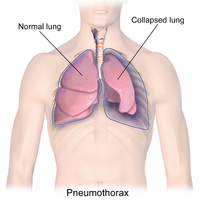
Photo from wikipedia
Abstract Aim of study: We aimed to investigate whether the difference in pleural pressures (ΔP) is wider among patients who develop a residual pneumothorax after chest tube removal following lung… Click to show full abstract
Abstract Aim of study: We aimed to investigate whether the difference in pleural pressures (ΔP) is wider among patients who develop a residual pneumothorax after chest tube removal following lung resection surgery. Materials and methods: Ninety-eight patients who underwent lung resection were included in the study over a period of 12 months. The ΔP prior to chest tube removal in patients who developed a residual pneumothorax after chest tube removal was compared with that of patients who did not develop this complication. The receiver operating characteristic (ROC) curve analysis was performed to identify cutoff values of ΔP for the prediction of residual pneumothorax. Logistic regression analysis was used to formulate a prediction model for the occurrence of residual pneumothorax based on ΔP. Results: Thirteen patients who developed a residual pneumothorax were compared with 85 patients without this complication. The ΔP in the residual pneumothorax group was significantly higher (10.8 versus 4.2 cm H2O, p < 0.01). The ΔP in patients who required intervention was also significantly higher (14.8 versus 4.2 cm H2O, p < 0.01). A ΔP cutoff value of 8 cm H2O was predictive of the occurrence of residual pneumothorax (sensitivity 85.6%, specificity 84.6%) and a value of 12 cm H2O was predictive of intervention (sensitivity 84%, specificity 85%). Increasing ΔP was an independent predictor of the occurrence of residual pneumothorax (p = 0.008) on the multivariate logistic regression model. Conclusion: Patients with wide ΔP before chest drain removal may be complicated with residual pneumothorax.
Journal Title: Journal of Investigative Surgery
Year Published: 2018
Link to full text (if available)
Share on Social Media: Sign Up to like & get
recommendations!